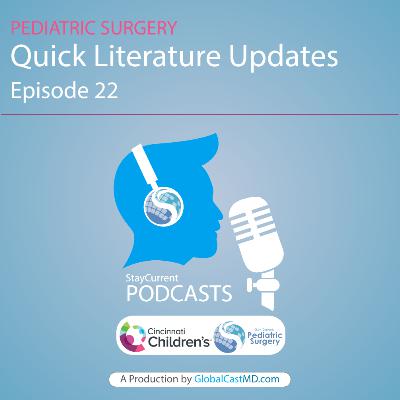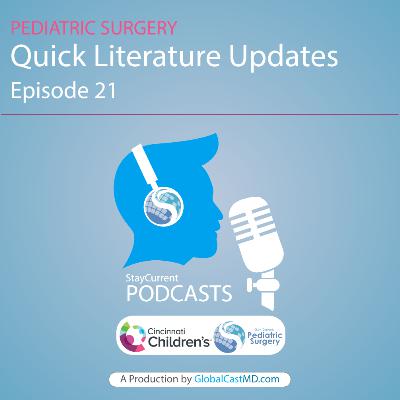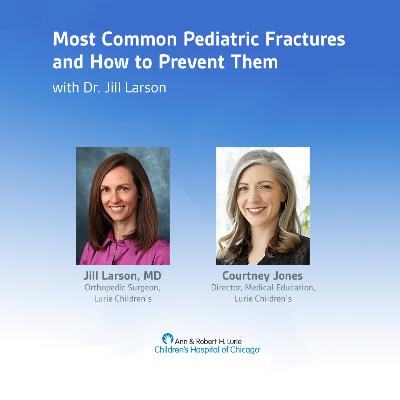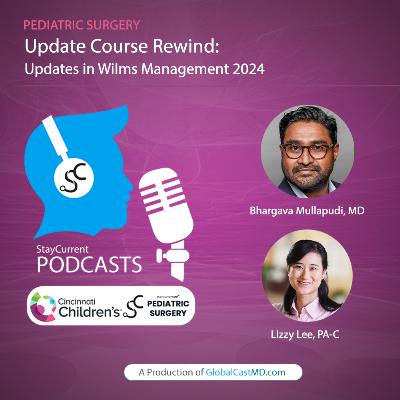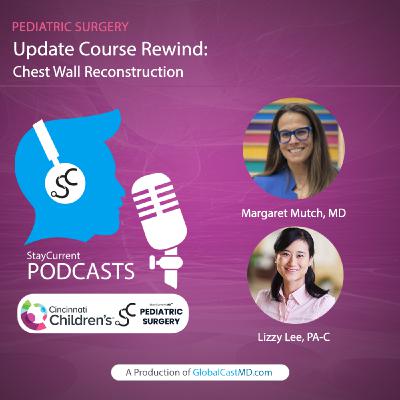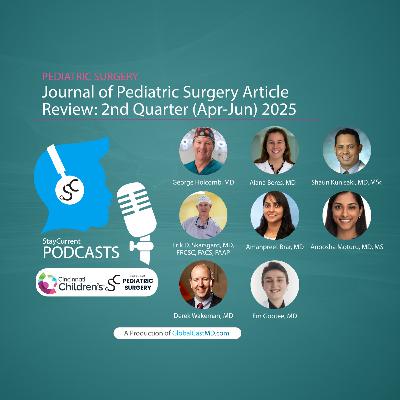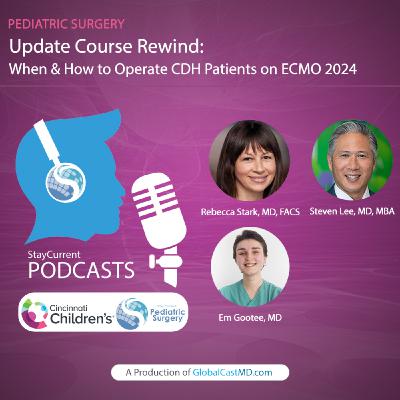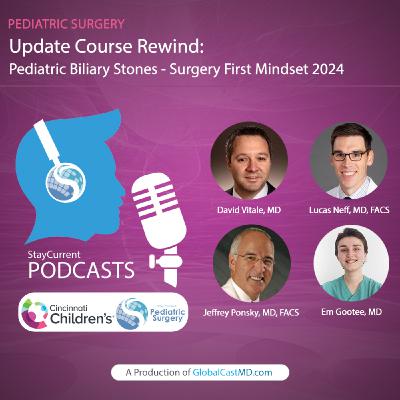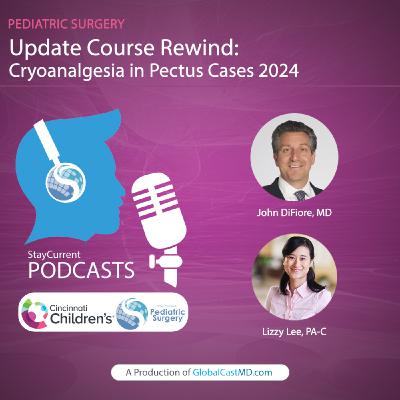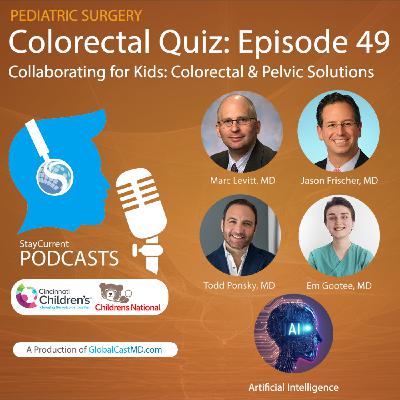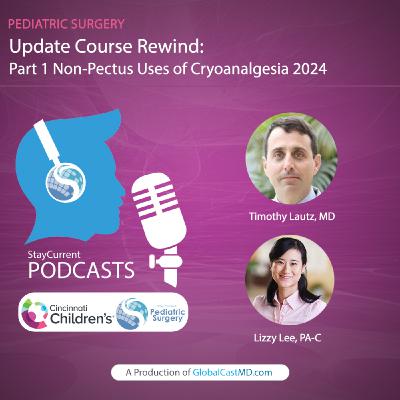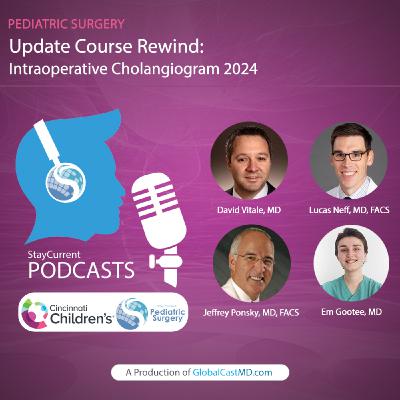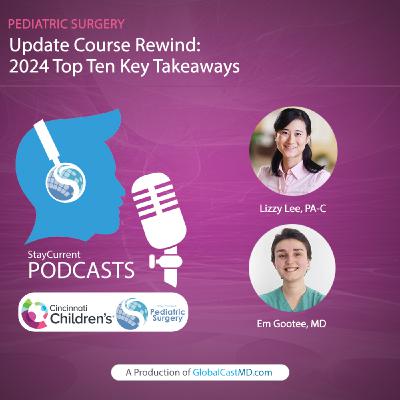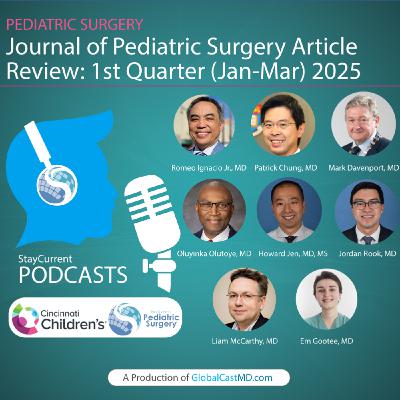Discover Stay Current in Pediatric Surgery
Stay Current in Pediatric Surgery

Stay Current in Pediatric Surgery
Author: StayCurrent: Pediatric Surgery
Subscribed: 180Played: 5,207Subscribe
Share
© All rights reserved
Description
Through GlobalCastMD’s world-class network of physicians and technology, any health system can provide their doctors access to ongoing mentoring and education. Companies can leverage this same network to more effectively train physicians on products and use it to help train their own sales force. Our educational materials aim to provide entertaining, interactive education for anyone, regardless of geography. We truly are: Dedicated to the rapid advancement of care. Everywhere.
421 Episodes
Reverse
We’re back with 22nd episode of "Quick Literature Updates" the podcast series that delivers the latest updates in pediatric surgery literature in a quick and digestible format. In each episode, we review articles covering the most interesting and relevant topics in the field.These articles are either chosen by JPS editors or our collaborators. We present these reviews as short news pieces with a summarization of key points.Whether you're a trainee, attending, or an advanced medical professional, tune in to our podcast for a dose of medical knowledge in every episode. Stay up to date on the latest trends and advancements in pediatric surgery with "Quick Literature Updates".Host: Em Gootee0:00 Introduction0:39 The use of postoperative calibrations in Hirschsprung disease: a practice to reconsider?1:47 Management of Gastroschisis: Timing of Delivery, Antibiotic Usage, and Closure Considerations2:57 Treatment Facility Case Volume and Disparities in Outcomes of Congenital Diaphragmatic Hernia Cases4:06 OutroNCBI - WWW Error Blocked DiagnosticBeati F, D'Angelo T, Iacusso C, Iacobelli BD, Scorletti F, Valfré L, Pellegrino C, Bagolan P, Conforti A, Fusaro F. The use of postoperative calibrations in Hirschsprung disease: a practice to reconsider? Pediatr Surg Int. 2024 Jul 5;40(1):176. doi: 10.1007/s00383-024-05761-6. PMID: 38967682.NCBI - WWW Error Blocked DiagnosticSlidell MB, McAteer J, Miniati D, Sømme S, Wakeman D, Rialon K, Lucas D, Beres A, Chang H, Englum B, Kawaguchi A, Gonzalez K, Speck E, Villalona G, Kulaylat A, Rentea R, Yousef Y, Darderian S, Acker S, St Peter S, Kelley-Quon L, Baird R, Baerg J. Management of Gastroschisis: Timing of Delivery, Antibiotic Usage, and Closure Considerations (A Systematic Review From the American Pediatric Surgical Association Outcomes & Evidence Based Practice Committee). J Pediatr Surg. 2024 Aug;59(8):1408-1417. doi: 10.1016/j.jpedsurg.2024.03.044. Epub 2024 Apr 30. PMID: 38796391.NCBI - WWW Error Blocked DiagnosticPeiffer SE, Mehl SC, Powell P, Lee TC, Keswani SG, King A. Treatment Facility Case Volume and Disparities in Outcomes of Congenital Diaphragmatic Hernia Cases. J Pediatr Surg. 2024 May;59(5):825-831. doi: 10.1016/j.jpedsurg.2024.01.042. Epub 2024 Feb 4. PMID: 38413264.
We’re back with 21st episode of "Quick Literature Updates" the podcast series that delivers the latest updates in pediatric surgery literature in a quick and digestible format. In each episode, we review articles covering the most interesting and relevant topics in the field.These articles are either chosen by JPS editors or our collaborators. We present these reviews as short news pieces with a summarization of key points.Whether you're a trainee, attending, or an advanced medical professional, tune in to our podcast for a dose of medical knowledge in every episode. Stay up to date on the latest trends and advancements in pediatric surgery with "Quick Literature Updates".Host: Em GooteeNCBI - WWW Error Blocked DiagnosticLi S, Wang J, Li M, Zhang Z, Mi T, Wu X, Wang Z, Jin L, He D. Efficacy and late kidney effects of nephron-sparing surgery in the management of unilateral Wilms tumor: a systematic review and meta-analysis. Pediatr Surg Int. 2023 Dec 27;40(1):29. doi: 10.1007/s00383-023-05611-x. PMID: 38150145.NCBI - WWW Error Blocked DiagnosticGillipelli SR, Pio L, Losty PD, Abdelhafeez AH. Female Fertility Cryopreservation Outcomes in Childhood Cancer: A Systematic Review. J Pediatr Surg. 2024 Aug;59(8):1564-1568. doi: 10.1016/j.jpedsurg.2024.02.015. Epub 2024 Mar 1. PMID: 38519388.NCBI - WWW Error Blocked DiagnosticWitte AB, Van Arendonk K, Bergner C, Bantchev M, Falcone RA Jr, Moody S, Hartman HA, Evans E, Thakkar R, Patterson KN, Minneci PC, Mak GZ, Slidell MB, Johnson M, Landman MP, Markel TA, Leys CM, Cherney Stafford L, Draper J, Foley DS, Downard C, Skaggs TM, Lal DR, Gourlay D, Ehrlich PF. Venous Thromboembolism Prophylaxis in High-Risk Pediatric Trauma Patients. JAMA Surg. 2024 Oct 1;159(10):1149-1156. doi: 10.1001/jamasurg.2024.2487. PMID: 39083300; PMCID: PMC11292570.
In this session from the 12th Annual Update Course in Pediatric Surgery, Dr. Jill Larson from Ann & Robert H. Lurie Children’s Hospital outlines key strategies for preventing and managing the most common pediatric fractures—just in time for the seasonal surge.Key Highlights:• Timing of fractures: Fracture season peaks in spring, summer, and surprisingly, October—timing your prevention efforts matters• Top five fracture types: Wrist, ankle, elbow, forearm, and tibia fractures are the most common injuries treated in pediatric orthopedics.• What to treat—and how: Dr. Larson explains which fractures can be managed conservatively (e.g., buckle or greenstick) and which may need surgery (e.g., displaced triplane fractures).• Casting and immobilization tips: Includes guidance on when to splint, when to cast, and how long to monitor growth plate–involved injuries.• Injury prevention insights: From trampoline accidents to lawnmower-related trauma, this session covers key safety risks and how to address them proactively.• Nutrition and bone health: Vitamin D deficiency and obesity are contributing factors—highlighting the need for a holistic approach to fracture prevention.This session provides practical, seasonal insights for pediatric providers—and equips teams with the knowledge to protect growing bones before peak fracture months arrive.
In this session from the 12th Annual Update Course in Pediatric Surgery, Dr. Bhargava Mullapudi (Children’s Mercy Kansas City) presents updated strategies in Wilms tumor management, exploring how tumor biology and global guidelines are shaping decisions on surgery vs chemotherapy first.Key Highlights:COG vs SIOP Guidelines: North American centers (COG) typically favor primary surgery, while European protocols (SIOP) begin with chemotherapy—highlighting major global practice differences.Impact of Tumor Genetics: Loss of heterozygosity (LOH) at chromosomes 1p and 16q, as well as gain of 1q, influence chemotherapy decisions even in lower-stage disease.Staging and Size Aren’t Enough: While age and tumor weight are considered, biological markers ultimately guide treatment, challenging simplified “under 2 years / under 550g” rules.Shifting Practice Patterns: Even for Stage I tumors, presence of LOH may justify adding chemotherapy, depending on evolving Children’s Oncology Group recommendations.Pathology-Informed Protocols: Surgeons must often pause for biological profiling before placing ports or initiating adjuvant therapy.This presentation underscores the importance of precision medicine in Wilms tumor care—and how treatment pathways increasingly rely on molecular markers, not just stage and weight.
In this session from the 12th Annual Update Course in Pediatric Surgery, Drs. Rebecca Stark and Steven Lee from Seattle Children’s Hospital walk through the timing, technique, and evolving protocols for performing ECMO and surgical repair in cases of severe congenital diaphragmatic hernia (CDH).Key Highlights:VA ECMO with bivalirudin: The presenters advocate for bivalirudin as a preferred anticoagulant over heparin due to its short half-life, predictable response, and ease of control—making it ideal for ECMO patients requiring surgery.Dilute thrombin time for monitoring: They highlight a lab-friendly technique for monitoring bivalirudin using dilute thrombin time—5x more specific and sensitive than PTT and easily implementable in any lab.Safe and timely surgical repair on ECMO: Early CDH repair (within 8–24 hours of ECMO initiation) can be performed with minimal bleeding and less tissue edema when using bivalirudin and meticulous technique.Institutional buy-in for early repair: The team underscores the importance of cross-disciplinary collaboration—including neonatologists, anesthesiologists, and weekend OR availability—to enable early ECMO repair protocols.Risk-stratified vs early repair strategy: Some centers risk-stratify ECMO patients, but Stark and Lee favor universal early repair to avoid complications associated with delayed surgery in non-weanable patients.Evolving national practices: As of this year, over 80% of CDH Study Group centers are now performing early repair on ECMO—showing how rapidly clinical protocols can shift with strong supporting data.This session emphasizes the role of proactive planning, team-based decision-making, and flexible protocol development in improving outcomes for neonates with severe CDH requiring ECMO.
In this session from the 12th Annual Update Course in Pediatric Surgery, Dr. Margaret Mutch from Australia walks through the complexities of chest wall reconstruction following thoracic osteosarcoma resection in a pediatric patient.Key Highlights:Massive resection and reconstruction: A 14-year-old patient underwent an aggressive en bloc resection involving ribs 4–7 and vertebral bodies T4–T7. The team used a combination of resorbable molded plates, Permacol mesh, and Gore-Tex patches to stabilize and recreate the chest wall structure.Soft tissue closure with latissimus flap: A latissimus dorsi flap was mobilized for robust coverage, reducing dead space and supporting tissue healing over the reconstructed area.Use of ROLL technique for lymph node excision: The team employed radio-guided occult lesion localization (ROLL) using Technetium-99 to precisely identify and remove targeted lymph nodes.Managing early complications: Postoperative challenges included sterile seromas, a wound infection, and mild scoliosis—all managed conservatively with good outcomes.Addressing recurrence and reoperation: When local recurrence occurred 18 months later, a second reconstruction involving the sternum and cement mesh was required, illustrating the long-term complexity of these cases.Future outlook for pediatric reconstructions: Dr. Mutch emphasized the lack of standardization in pediatric materials and techniques, pointing toward a future where custom 3D-printed implants and biologics may offer better long-term solutions.This session highlights the surgical precision, interdisciplinary coordination, and resilience required to manage large-scale reconstructions in growing children—where both oncologic control and functional outcomes must be balanced.
We are back with another episode of our Journal of Pediatric Surgery article review podcast. This time we have three publications from the second quarter of 2025, April, May and June issues. This time we're talking to editors Drs. George Holcomb III, Alana Beres and Shaun Kunisaki joined by authors Drs. Eric Skarsgard, Amanpreet Brar, Anoosha Moturu and Derek Wakeman.Host: Em Gootee, MDArticles:https://pubmed.ncbi.nlm.nih.gov/39826297/Shieh HF, Jennings RW, Hamilton TE, Izadi S, Zendejas B, Smithers CJ. Tracheobronchopexy to Avoid Tracheostomy in Esophageal Atresia Patients With Severe Life-Threatening Tracheobronchomalacia. J Pediatr Surg. 2025 Apr;60(4):162152. doi: 10.1016/j.jpedsurg.2024.162152. Epub 2025 Jan 3. PMID: 39826297.https://pubmed.ncbi.nlm.nih.gov/39865003/Brar A, Gow KW, Skarsgard ED. Pediatric Surgical Outreach: An Underutilized Resource for Increasing Children's Surgical Capacity in Canada. J Pediatr Surg. 2025 May;60(5):162174. doi: 10.1016/j.jpedsurg.2025.162174. Epub 2025 Jan 19. PMID: 39865003.https://pubmed.ncbi.nlm.nih.gov/39743432/Moturu A, Coleman M, Mets C, Thompson V, Grant C, Ko CY, Saito JM, Berman L, Wakeman D. Identifying Quality Improvement Targets After Pediatric Gastrostomy Tube Insertion: A NSQIP-Pediatric Pilot Study. J Pediatr Surg. 2025 Jun;60(6):162107. doi: 10.1016/j.jpedsurg.2024.162107. Epub 2024 Dec 17. PMID: 39743432.
In this session from the 12th Annual Update Course in Pediatric Surgery, Drs. Rebecca Stark and Steven Lee from Seattle Children’s Hospital walk through the timing, technique, and controversies surrounding ECMO in severe congenital diaphragmatic hernia (CDH) cases.Key Highlights:VV vs VA ECMO: While venovenous (VV) ECMO is gaining traction with improved cannulas, venoarterial (VA) ECMO remains the predominant choice for most centers treating CDH.When to initiate ECMO: Early intervention is often favored in high-risk CDH cases, especially when prenatal imaging suggests severe compromise.SPHERE protocol in decision-making: A structured approach from Michigan offers criteria for ECMO vs comfort care, but outcome prediction remains unreliable—50% of decisions based on early data may be incorrect.Controversy in selection: Dr. Stark advocates for offering ECMO to all infants with isolated unilateral CDH, emphasizing the importance of treating every case as a potential survivor.Role of prenatal counseling: Early, transparent discussions with families are critical for navigating high-stakes decisions and aligning on care pathways.This session underscores both the technical and ethical complexity in managing severe CDH—and the need for thoughtful protocols paired with clinical flexibility.
In this session from the 12th Annual Update Course in Pediatric Surgery, Drs. David Vitale, Luke Neff, and Jeffrey Ponsky explore strategies for preventing gallstone pancreatitis in pediatric patients with biliary stones. This session is classified as a Green Circle (established practice).Key Highlights:Managing complex cases: When to use conservative management with antibiotics for neutropenic, thrombocytopenic patients.Gallstone pancreatitis: How to differentiate management from typical choledocholithiasis cases.Timing of cholecystectomy: Why surgery should be based on clinical improvement rather than complete biochemical normalization.ERCP and IOC coordination: Determining when early ERCP is necessary and incorporating intraoperative cholangiograms for safe stone clearance.Clinical judgment matters: How local resources and patient-specific factors shape decision-making.This session emphasizes balancing early intervention with patient safety and tailoring care to individual circumstances.
Welcome to the 12th Annual Update Course in Pediatric Surgery recap series, hosted by Dr. Em Gootee from Cincinnati Children’s Hospital. In this Green Circle (established practice) session, Drs. David Vitale, Luke Neff, and Jeff Ponsky explore the “surgery-first” approach to pediatric biliary stone disease, highlighting the growing prevalence of choledocholithiasis in children and the evolving strategies to manage it effectively.Key Highlights:Surgery-First vs. ERCP-First: The panel compares the two main management strategies: ERCP followed by laparoscopic cholecystectomy versus laparoscopic cholecystectomy with intraoperative cholangiogram (IOC) and stone removal.Practice-Based Decision Making: Experts emphasize that choice depends on surgeon skill, institutional resources, and the ability to perform IOC effectively.Clinical Evidence: Studies show an 86–90% success rate for ductal clearance using a surgery-first approach with IOC and flushing—offering a safe, resource-efficient option that minimizes ERCP-associated risks like pancreatitis.Learning Curve & Equipment: Surgeons are encouraged to become more comfortable with intraoperative stone removal techniques. Having a prepared kit and standardized workflow is key to success.ERCP Complications: While ERCP is effective, it carries a ~10% risk of complications including cholangitis and pancreatitis—making intraoperative solutions appealing when feasible.This session underscores a shift toward empowering surgeons with tools and confidence to manage choledocholithiasis directly in the OR, improving outcomes and optimizing resource utilization across institutions.
In this 2024 Update Course Rewind, pediatric surgeon Dr. John DiFiore shares new insights into the growing use of cryoanalgesia for pectus excavatum repairs. Classified as a “Blue Square” practice—indicating a promising newer technique—this approach provides targeted nerve pain relief with less opioid use, better precision, and shorter hospital stays.Key Highlights:What is Cryoanalgesia? A minimally invasive nerve freezing technique used to reduce chest wall pain during pectus repair.Technique Deep Dive: From double-lumen tubes to improved cryoprobes, learn how to perform blocks from T3–T8 with precision.Time-Saving Tools: New cryoprobes offer faster freeze cycles and better insulation, cutting procedure time nearly in half.Clinical Outcomes: Lower pain scores, next-day discharges, and potential to further improve outcomes with dual freeze points.Barriers & Workarounds: Addressing the main challenges of cost, equipment access, and proper training.Whether you're currently using cryo or just considering it, this session is packed with pearls for improving postoperative pain control in pediatric patients.
In this special episode of the Colorectal Quiz, Drs. Marc Levitt and Jason Frischer are joined by Dr. Todd Ponsky and Em Gootee for a behind-the-scenes look at how AI is supporting medical education. The topic of this quiz: Collaborating for Kids: Colorectal & Pelvic Solutions. What’s unique about this episode? Everything after the intro was generated using NotebookLM, an AI tool that helped synthesize notes, transcripts, and case studies into an engaging, educational format. Key Highlights:Case-Based Learning: A multidisciplinary team approach to treating children with complex colorectal and pelvic conditions.Building the Right Team: The importance of urologists, gynecologists, psychologists, and colorectal surgeons working together to improve outcomes.International Collaboration: How programs like the Pediatric Colorectal and Pelvic Learning Consortium (PCPLC) are advancing global standards of care.Family-Centered Care: Strategies for improving communication with families and providing continuity as patients transition into adulthood.Innovative Communication: A glimpse into the future of podcasting and education in pediatric surgery.This episode blends expert insight with cutting-edge technology to show what’s possible when collaboration meets innovation.Alejandra Vilanova-Sánchez, Julie Choueiki, Caitlin A. Smith, Susan Callicot, Jason S. Frischer, Marc A. Levitt. Creating a collaborative program for the care of children with colorectal and pelvic problems. Seminars in Pediatric Surgery 29 (202) 150985.
In this insightful recap from the 12th Annual Update Course in Pediatric Surgery, Dr. Thomas Inge of Lurie Children’s Hospital explores emerging uses of cryoanalgesia beyond pectus repair. The video delves into novel applications of cryotherapy for conditions like slipping rib syndrome and rib fractures—highlighting how interventional radiology tools, including percutaneous needle probes, can offer powerful pain relief and reduce narcotic use and hospital stay.Key Highlights:Slipping Rib Syndrome: Often overlooked in teens, this condition can be addressed with intercostal blocks and cryoablation.Percutaneous Cryoablation: A new frontier in treating rib fractures and chronic pain using ultrasound-guided techniques.Multidisciplinary Approach: Collaboration between surgery and IR expands treatment options for hard-to-diagnose chest wall pain.This session emphasizes the evolving role of cryoanalgesia as a versatile, minimally invasive tool in pediatric surgical care.
In this engaging session from the 12th Annual Update Course in Pediatric Surgery, Dr. Timothy Lautz explores the expanding role of cryoanalgesia in pediatric thoracotomy beyond pectus repair. As more institutions embrace this technique, Dr. Lautz breaks down its use, safety, and clinical advantages for thoracotomy pain control.Key Highlights:Beyond Pectus Repair: While commonly used for pectus excavatum, cryoanalgesia is now being applied in thoracotomy cases to improve postoperative recovery.How It Works: Temporary nerve blockade is achieved by freezing the intercostal nerves, reducing or eliminating the need for epidurals and long-term opioids.Safety & Recovery: The procedure is safe, repeatable, and allows even small children to benefit from reduced pain and faster recovery timelines.Clinical Implementation: Dr. Lautz offers insight into when and how his team applies cryo, including tips for technique, timing, and avoiding complications.This talk underscores the value of multidisciplinary collaboration and highlights how surgical innovation can reduce patient discomfort and streamline recovery.
In this insightful session from the 12th Annual Update Course in Pediatric Surgery, Drs. David Vitale, Luke Neff, and Jeff Ponsky break down the essentials of intraoperative cholangiography (IOC)—a technique that plays a key role in identifying biliary anatomy and managing stones.Key Highlights:Technique Tips: From contrast flushes to balloon dilation, the team shares practical advice on improving success rates during IOC.Clinical Decision-Making: When and how to incorporate glucagon, and when to call in GI for support.Avoiding Pitfalls: Recognizing common challenges, including misinterpretation of images and catheter misplacement.Collaborative Care: How surgical teams can streamline intraoperative strategy and reduce post-op complications through consistent IOC use.This session emphasizes IOC as a powerful tool when performed correctly—and reminds us that thoughtful execution and teamwork can make all the difference in surgical outcomes.
We’re back with 20th episode of "Quick Literature Updates" the podcast series that delivers the latest updates in pediatric surgery literature in a quick and digestible format. In each episode, we review articles covering the most interesting and relevant topics in the field. These articles are either chosen by JPS editors or our collaborators. We present these reviews as short news pieces with a summarization of key points. Whether you're a trainee, attending, or an advanced medical professional, tune in to our podcast for a dose of medical knowledge in every episode. Stay up to date on the latest trends and advancements in pediatric surgery with "Quick Literature Updates".Host: Em Gootee0:00 Introduction0:41 Comprehensive meta-analysis of surgical procedure for congenital diaphragmatic hernia: thoracoscopic versus open repair1:35 Use of a new vertical traction device for early traction-assisted staged closure of congenital abdominal wall defects: a prospective series of 16 patients2:39 Indocyanine green (ICG) fluorescent cholangiography during laparoscopic cholecystectomy using RUBINA™ technology: preliminary experience in two pediatric surgery centers3:47 Outrohttps://pmc.ncbi.nlm.nih.gov/articles/PMC11233350/ Shibuya S, Paraboschi I, Giuliani S, Tsukui T, Matei A, Olivos M, Inoue M, Clarke SA, Yamataka A, Zani A, Eaton S, De Coppi P. Comprehensive meta-analysis of surgical procedure for congenital diaphragmatic hernia: thoracoscopic versus open repair. Pediatr Surg Int. 2024 Jul 9;40(1):182. doi: 10.1007/s00383-024-05760-7. Erratum in: Pediatr Surg Int. 2024 Aug 31;40(1):247. doi: 10.1007/s00383-024-05832-8. PMID: 38980431; PMCID: PMC11233350.https://pubmed.ncbi.nlm.nih.gov/38960901/ Ziegler AM, Svoboda D, Lüken-Darius B, Heydweiller A, Kahl F, Falk SC, Rolle U, Theilen TM. Use of a new vertical traction device for early traction-assisted staged closure of congenital abdominal wall defects: a prospective series of 16 patients. Pediatr Surg Int. 2024 Jul 3;40(1):172. doi: 10.1007/s00383-024-05745-6. PMID: 38960901; PMCID: PMC11222185. https://pubmed.ncbi.nlm.nih.gov/34231069/ Esposito C, Alberti D, Settimi A, Pecorelli S, Boroni G, Montanaro B, Escolino M. Indocyanine green (ICG) fluorescent cholangiography during laparoscopic cholecystectomy using RUBINA™ technology: preliminary experience in two pediatric surgery centers. Surg Endosc. 2021 Nov;35(11):6366-6373. doi: 10.1007/s00464-021-08596-7. Epub 2021 Jul 6. PMID: 34231069; PMCID: PMC8523512.Don't forget to like and subscribe to see more entertaining medical educational videos!See more lectures, articles, and more on the Stay Current app: https://www.globalcastmd.com/stay-current-app-download
In this episode of the Colorectal Quiz, Drs. Marc Levitt, Jason Frischer, and special guest Dr. Julia Grabowski from Lurie Children’s dive deep into the diagnosis and management of anal stenosis in infants. They walk through the case of a 10-month-old presenting with constipation and distention, leading to a discussion on clinical exams, imaging, biopsy pitfalls, and surgical strategies.Key Highlights:Physical Exam Essentials: Why a thorough digital rectal exam is critical and when to use a Hegar dilator vs. relying on feel.Distinguishing Anal Stenosis vs. Hirschsprung Disease: How misdiagnoses occur and why biopsies can be misleading if not done correctly.Surgical Management: Principles of preserving the anterior anal canal to protect continence during posterior sagittal approaches.Megarectosigmoid Management: Why most dilated rectums improve after addressing the obstruction and when a Malone procedure can prevent the need for resection.Special Considerations: The importance of spinal and pelvic MRI to rule out associated presacral masses before surgery.This episode underscores the importance of a meticulous clinical approach, interdisciplinary review, and cautious surgical planning in treating children with suspected anal stenosis.
Join us for a highlight reel of the Top 10 Key Takeaways from the 12th Annual Update Course in Pediatric Surgery. This session covers the latest advances, practical tools, and emerging trends that are shaping the future of pediatric surgical care.Key Highlights:10. Collaboration Between Surgery & Interventional Radiology: Drs. Dan von Allmen, John Racadio, and Timothy Lautz highlight how combining surgical and interventional radiology techniques enhances precision and patient outcomes.9. Top AI Tools for Surgeons: Drs. Ramy Shaaban and Carlos Colunga introduce AI platforms improving research, education, and clinical workflow.8. Cryoanalgesia in Pectus Surgery: Dr. John DiFiore explains how cryoanalgesia is transforming pain management in chest wall repairs.7. ECMO in Severe CDH: Drs. Steven Lee and Rebecca Stark explore ECMO’s evolving role in managing severe congenital diaphragmatic hernia.6. CO₂ Laser Applications: Dr. Carlos Colunga shares expanding applications of CO₂ lasers for minimally invasive pediatric procedures.5. Autofluorescence & ICG in Thyroid Surgery: Drs. Justin Huntington and Ben Ham showcase imaging technologies that improve parathyroid identification and reduce hypocalcemia.4. Surgery-First Approach for Pediatric Biliary Stones: Drs. David Vitale, Luke Neff, and Jeff Ponsky advocate for earlier surgical intervention to avoid unnecessary imaging.3. MMP-7 for Early Biliary Atresia Diagnosis: Dr. Greg Tiao presents the impact of MMP-7 as a biomarker for faster diagnosis and better outcomes.2. REBOA in Pediatric Trauma: Dr. Regan Williams discusses the role of resuscitative endovascular balloon aortic occlusion in critical pediatric trauma cases.1. Patient Education in Pilonidal Disease: Dr. Nelsen Rosen outlines strategies to manage pilonidal disease non-surgically through hygiene and hair removal.These takeaways represent the cutting edge of pediatric surgery, offering practical insights for surgeons, researchers, and trainees alike.
This year was the 12th Annual Pediatric Surgery Update Course, where top hospital experts from around the world discussed this year’s changes in practices and innovation. Rewatch the event to learn more about the future of pediatric surgery and be at the forefront of medical excellence. In this clip, Drs. Em Gootee, Ramy Shaaban, Carlos Colunga, with Todd Ponsky as moderator, speaks on the top AI tools of 2024.Topics to be discussed:• AI: TOP 10 websites & tools for everyday usage
We are back with another episode of our Journal of Pediatric Surgery article review podcast. This time we have three publications from the first quarter of 2025, January, February and March issues. This time we're talking to editors Drs. Romeo Ignacio, Patrick Chung and Mark Davenport joined by authors Drs. Oluyinka Olutoye, Howard Jen, Jordan Rook and Liam McCarthy.Host: Em Gootee, MDArticles:Gadde R, Xia J, Hameedi S, Saulsbery A, Schafer C, Sbragia L, Olutoye OO. Remote Ischemic Conditioning (RIC) Decreases the Incidence and Severity of Necrotizing Enterocolitis (NEC) - Validation in a Large Animal Model. J Pediatr Surg. 2025 Jan;60(1):161957. doi: 10.1016/j.jpedsurg.2024.161957. Epub 2024 Sep 24. PMID: 39368858.https://pubmed.ncbi.nlm.nih.gov/39368858/Rook JM, Lee LK, Wagner JP, Sullins VF, Lee SL, Shekherdimian S, DeUgarte DA, Dichter CE, Jen HC. Six Years of Quality Improvement in Pectus Excavatum Repair: Implementation of Intercostal Nerve Cryoablation and ERAS Protocols for Patients Undergoing Nuss Procedure. J Pediatr Surg. 2025 Feb;60(2):161634. doi: 10.1016/j.jpedsurg.2024.07.019. Epub 2024 Jul 20. PMID: 39117536.https://pubmed.ncbi.nlm.nih.gov/39117536/Parkinson E, Robb A, McCarthy L. Long-term Survival of Bladder Augmentation is Influenced by its Shape and Mucosal Lining. J Pediatr Surg. 2025 Mar;60(3):162051. doi: 10.1016/j.jpedsurg.2024.162051. Epub 2024 Nov 1. PMID: 39572279.https://pubmed.ncbi.nlm.nih.gov/39572279/


